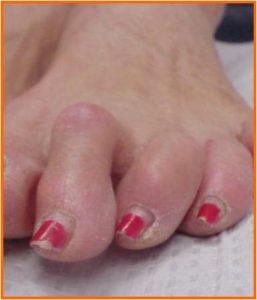A hammer toe is a contracture, or bending, of the toe at the first joint of the digit, called the proximal interphalangeal joint. This bending causes the toe to appear like an upside-down V when looked at from the side . Any toe can be involved, but the condition usually affects the second through fifth toes, known as the lesser digits. Hammer toes are more common in females than males.
. Any toe can be involved, but the condition usually affects the second through fifth toes, known as the lesser digits. Hammer toes are more common in females than males.
A hammer toe develops because of an abnormal balance of the muscles in the toes. This abnormal balance causes increased pressures on the tendons and joints of the toe, leading to its contracture. Heredity and trauma can also lead to the formation of a hammer toe. Arthritis is another factor, because the balance around the toe in people with arthritis is disrupted. Wearing shoes that are too tight and cause the toes to squeeze can also cause a hammer toe to form.
The symptoms of a hammer toe include the following:
- Pain at the top of the bent toe upon pressure from footwear
- Formation of corns on the top of the joint
- Redness and swelling at the joint contracture
- Restricted or painful motion of the toe joint
- Pain in the ball of the foot at the base of the affected toe
Prevention
A lot of patients ask us how to prevent hammer toes from forming. Here are a few tips to prevent hammer toes:
- Wear supportive shoes to help prevent deformities. Hammer toes are often related to faulty foot mechanics, especially foot flattening.
- Wear custom orthotics prescribed by your podiatrist. Orthotics may slow the progression or prevent the development of hammer toes.
- Avoid shoes with narrow or pointed toe boxes that can compress the toes.